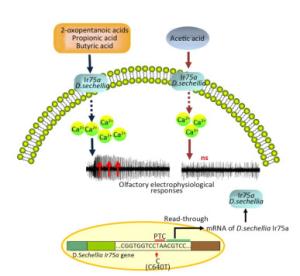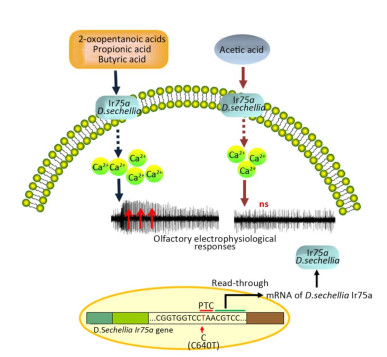-
Recently, Prieto-Godino et al.[1] found that the olfactory receptor 75a (Ir75a) gene is a functional pseudo-pseudogene in Drosophila sechellia. For a long time, Ir75a has been regarded as an acetic acid receptor that detects acetic acid and induces obvious olfactory responses in olfactory sensory neurons (OSNs)[2]. Nonetheless, Prieto-Godino et al. confirmed that Ir75a lost its sensitivity to acetic acid in D. sechellia. Thus, the D. sechellia Ir75a gene is generally recognized as a pseudogene in OSNs. Nevertheless, the D. sechellia Ir75a gene is not a simple pseudogene. Prieto-Godino et al. found that D. sechellia Ir75a is sensitive to propionic, butyric, and 2-oxopentanoic acids. Therefore, the D. sechellia Ir75a gene encodes a functional olfactory receptor (OR) that induces different olfactory responses.
The above results suggest that the OR gene should not be simply regarded as an olfactory pseudogene. Numerous studies indicate that the OR gene family is the largest gene family in human and mammalian genomes. There are approximately 1, 000 OR genes identified in humans, whereas only 40% of OR genes have an intact coding region and are putatively functional[3]. Most of OR gene families are recognized as nonfunctional pseudogenes. Research has revealed, however, that many OR pseudogene fragments are translated, thus playing an important role in human cells[4]. Therefore, the OR gene is not a plain pseudogene, although the function of the OR pseudogene-derived proteins is unclear. Moreover, OR genes encode the largest subfamily of G protein-coupled receptors[5], and ORs are abundantly expressed in OSNs. ORs are activated by odorant ligands such as short-chain fatty acids, lactate, aldehydes, ketones, phenols, and alcohols. The activation of ORs can produce obvious smell perception by increasing intracellular Ca2+ in an OSN.
What are the reasons for the acquisition of a function by D. sechellia Ir75a? The read-through of a premature termination codon (PTC) permits the translation of D. sechellia Ir75a and changes the protein. Some studies show a homozygous mutation CAC to AA with an out-of-frame 1-bp deletion, which can lead to the stop codon read-through in the NADH-cytochrome b5 reductase gene[6]. In the D. sechellia Ir75a pseudogene, the C640T (CAA→TAA) nucleotide substitution in the open reading frame creates a PTC in exon 4, and this PTC permits read-through. The Ir75a PTC exists only in all the D. sechellia strains but not in any D. melanogaster or D. simulans strain. Read-through of the PTC allows for translation of the downstream sequence, leading to the extensions of the C terminus in D. sechellia Ir75a. Moreover, D. sechellia Ir75a gene read-through is detected only in diverse neuronal classes but not in non-neuronal cells. The neuron-specific read-through may be caused by an enriched tRNA in neurons. A tRNA can effectively recognize the Ir75a PTC and enables insertion of an amino acid instead of translation termination in D. sechellia.
The structure and function of the Ir75a protein are altered by the mutation and read-through in D. sechellia. Abundant studies suggest that a frame shift mutation triggers an alteration of hydrophobicity in the carboxyl-terminal portion, thereby resulting in disturbances of the structure and function of the protein[6]. In D. sechellia Ir75a, some changes occur at three mutation-prone ligand-binding positions including T289S, Q536K, and F538L. Moreover, D. melanogaster Ir75a can yield similar olfactory responses to propionic, butyric, and 2-oxopentanoic acids when mutated at these three positions. To some degree, these three positions can determine the sensitivity of Ir75a to different acids. Additionally, compared to D. simulans and D. melanogaster Ir75a, the side chains of the residues are different in D. sechellia Ir75a. Overall, these mutation-prone ligand-binding positions and residues as determinants of olfactory specificity are essential for the different ligand response profiles in ORs.
Pseudo-pseudogenes are a widespread phenomenon in various species. Prieto-Godino et al. also found other OR pseudo-pseudogenes such as Raleigh707 Ir75b, Raleigh441 Ir31, and Tasmanian09 Ir31[1]. A nucleotide substitution results in a PTC of Ir75b and Ir31a. Moreover, Ir75b and Ir31a produce different olfactory responses to acids as compared with the D. melanogaster controls. These results suggest that OR pseudo-pseudogenes are a common phenomenon in Drosophila. OR pseudo-pseudogenes are not restricted to a particular species or a specific receptor repertoire. Furthermore, pseudo-pseudogenes are recognized as a result of natural selection, e.g., via food, habitat, or spouse. In the process of evolution, mutations and read-through of OR genes have produced a functional OR and ultimately ensured different olfactory responses.
A pseudo-pseudogene determines the population size of some species. In the process of evolution, a gene in some species is altered for adaptation to a change in the environment or food. On Seychelle islands, the ripe fruit of Morinda citrifolia is almost exclusive food for D. sechellia. Acetic acid is detectable at trace levels in the Morinda fruit. Hence, a nucleotide substitution and formation of a PTC happened in the D. sechellia Ir75a gene in order to adapt to the environment of Seychelle islands. The read-through of the PTC enables emergence of a function that allows for a low effective population size of D. sechellia among Drosophila species. Moreover, the odor-tuning properties of D. sechellia Ir75a have evolved, leading to a loss of the sensitivity to acetic acid and an increase in sensitivity to other acids. Therefore, the low effective population size of D. sechellia has persisted in Drosophila species on Seychelle islands.
The phenomenon of pseudo-pseudogenes may be involved in human diseases. Pseudogenes are still considered nonfunctional DNA relics in the human genome. Only lately was it well demonstrated that pseudogenes have widespread biological functions. Additionally, some pseudogenes may be a pseudo-pseudogene, which possibly play an important role in human disease. Research indicates that long noncoding RNAs transcribed from a pseudogene as crucial regulatory molecules are involved in human diseases such as cancer[7]. Besides, some studies show that PTC read-through is known only in viruses[8]. Human diseases can be associated with alleles that have low read-through rates[9]. Moreover, ORs are not only expressed in diverse olfactory neuronal classes but also ectopically expressed in human nonolfactory tissues or organs such as the heart, sperm, and skin cells as well as cancer tissues[10]. Ectopic ORs even perform diverse functions in nonolfactory tissues or organs[11]. Thus, OR pseudo-pseudogenes potentially generate variants by read-through in humans, and this mechanism may participate in the functional divergence of ORs and the development of a disease. Studies indicate that a novel mutation can occur in the NADH-cytochrome b5 reductase gene in type Ⅱ recessive congenital methemoglobinemia[6]. Moreover, a frameshift with translational read-through of the natural stop codon is induced in the NADH cytochrome b5 reductase gene owing to a mutation and may lead to the development of type Ⅱ recessive congenital methemoglobinemia. Therefore, targeting of the read-through induced by a mutation may be a novel treatment of type Ⅱ recessive congenital methemoglobinemia. Identification of this read-through enables researchers to determine the molecular mechanism of action of DNA mutations in diseases. Thus, pseudo-pseudogene Ir75a is a functional DNA sequence in D. sechellia and is translated via PTC read-through (Figure 1). The function of this pseudo-pseudogene requires more research on human diseases.

Figure 1. D. sechellia Ir75a is a functional olfactory receptor. A C640T (CAA→TAA) nucleotide substitution occurs in the D. sechellia Ir75a gene leading to the formation of a PTC. Read-through of this PTC allows for translation of D. sechellia Ir75a mRNA and the production of a functional olfactory receptor. This way, D. sechellia Ir75a has acquired greater sensitivity to propionic, butyric, and 2-oxopentanoic acids.
Conflict of Interest This manuscript is a review article and does not involve a research protocol requiring approval by the relevant institutional review board or ethics committee. The authors declare no conflicts of interest.
The Olfactory Receptor Pseudo-pseudogene: A Potential Therapeutic Target in Human Diseases
doi: 10.3967/bes2018.022
grants from the National Natural Science Foundation of China 81670265
Hunan Province Cooperative Innovation Center for Molecular Target New Drugs Study (Hunan Provincial Education Department document) Approval number:2014-405
grants from the National Natural Science Foundation of China 81503074
grants from the National Natural Science Foundation of China 81470434
- Received Date: 2017-07-26
- Accepted Date: 2017-12-12
| Citation: | CHEN Zhe, HUANG Zhen, CHEN Lin Xi. The Olfactory Receptor Pseudo-pseudogene: A Potential Therapeutic Target in Human Diseases[J]. Biomedical and Environmental Sciences, 2018, 31(2): 168-170. doi: 10.3967/bes2018.022 |








 Quick Links
Quick Links
 DownLoad:
DownLoad: